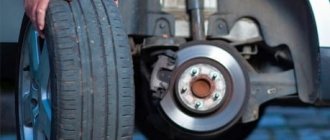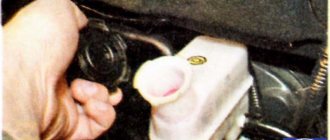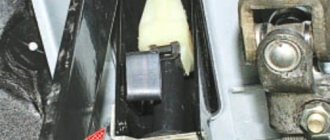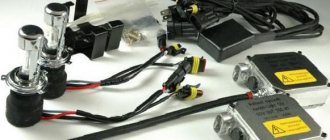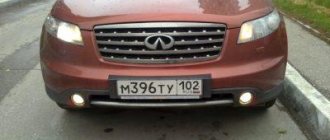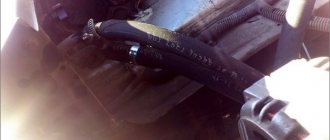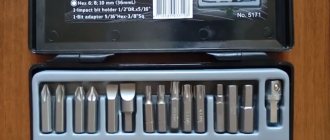- home
- DRIVING LESSONS
- …
How to brake correctly in a car? This question plagues many novice drivers. After all, when driving a car, it is important not only to start moving, but also to brake correctly. So, let's watch our fifth car video lesson...
First, let's define what braking is. I roughly divided it into three types:
1) Normal
2) Extreme
3) Engine braking
Let's look at the topic first:
Normal braking
Every day we move in the flow of cars and each of us drivers makes dozens of brakes. This is a very important process in any driving, so you need to learn how to do it correctly. Personally, I usually do this
I accelerate the car, going through gears - first, second, third, fourth. (Here you can watch a video on how to correctly change gears on a car.)
When in the distance I see a traffic light, for example, or a turn, I turn off the gear and sway in neutral, keeping my foot only on the brake pedal.
Then, when the distance remains a little (for example, before a traffic light or a turn), I press the brake more intensely, but smoothly, and the car stops smoothly.
In this way you can achieve a very smooth stopping of the car.
To make it more clear, watch all this in the video.
Let's now look at extreme braking in our topic:
How to properly drive a car in traffic jams
Congratulations to the woman driver
The presence of an automatic transmission greatly simplifies the driving process for the driver. But the situations along the route are so different and you need to learn how to use the automatic transmission correctly so as not to create unfavorable or dangerous moments on the road.
The automatic transmission consists of special modes that are switched by the driver using the selector (control lever). Special switches and buttons located on the selector (lever) allow you to apply the desired mode depending on the given situation. The selector has four main positions, indicated by numbers or letters:
- “P” (“Parking”) - stop. The choice of this position is designed to stop, for example, in a parking lot, the transmission brake is activated, which blocks further movement of the car;
- “N” (“Neutral”) is the neutral position of the vehicle, at which the engine and wheels are separated. Using this mode, the car can roll completely freely, for example, downhill;
- “R” (“Reverse”) - turning on the rear movement of the car;
- “D” (“Drive”) - starting this position involves the car moving forward, after which all gears begin to be put into operation in an increasing order due to an increase in speed and in a descending order when the speed of the car decreases;
- “Over Drive” - this position excludes the start of the highest gear. This position is applicable in a car with a high load, during long city driving, where there is continuous braking and acceleration.
A number of positions, such as sports, economical or winter, are designed for more efficient driving. Acceleration, braking, fuel economy, driving on snowy or slippery roads allows you to use the gearbox most productively with the least losses.
Control lever positions from 1 to 4 provide:
- "1" - first gear. Used on off-road, steep climbs. When starting this position, it is easiest to slow down;
- “2” - first and second gear. Used on difficult routes, on mountain roads. This gear is very convenient when you need to get going on a slippery road;
- "3" - the first three gears. They are used for the city, where there are no hills and slopes, steep descents, and for braking using a motor;
- "4" - the first four gears. Suitable for five-speed automatic transmission. This position is applicable in standard urban conditions with heavy traffic, where there is fairly frequent braking or acceleration.
The automatic transmission (automatic transmission) has a lever with a lock that will prevent the selector from being in the wrong position in a certain situation. At the same time, it is difficult for the driver to make a mistake. Due to inattention, ignorance and lack of experience, you can mistakenly use one or another position of the lever, which can cause serious damage to the gearbox.
Driving within the city involves intensive use of the gearbox. Continuous acceleration and braking while stopping at traffic lights or standing in traffic jams requires a careful and extremely attentive attitude to the use of automatic transmission. When standing in traffic jams for a long time (more than ten minutes), it is necessary to move the control lever from “D” to the “N” position, especially in hot weather, in order to avoid intense heat transfer and overheating of the oil in the automatic transmission. But, when switching to this mode, all automatic transmission mechanisms will be turned on, which, during prolonged operation, can reduce its vital activity.
During a long stop of the car, for example, at a railway crossing, you can move the lever to the “P” position. In general, the gearbox automatically suggests the correct action to avoid mistakes. The less you touch it, the better and safer. Constantly switching different positions on and off can shorten the life of the transmission.
In short traffic jams or in front of a traffic light during a stop, it is better to stay in mode “3” and hold the car with the brakes. When using an automatic transmission, it is forbidden to move towards the intersection by “rolling over” with the “N” position on the lever engaged. This mode is used to tow a vehicle or to restart a stalled engine.
Extreme braking
It is used mainly in critical cases, for example, a child or a pedestrian runs out onto the road (it could also be an animal - cats and dogs often run out on the sly) or the car in front suddenly stops,
There is nothing complicated here, only your reaction is needed. You need to press down the clutch and brake pedal as hard as you can at the same time. The car should stop abruptly, then shift out of gear. I would like to add that sometimes cars stop abruptly or simply in an extreme manner, so you (especially novice drivers) must be very careful while driving.
Video version
And the last way to stop, in our article:
We have it separately, it sounds like this: -
Hello everyone, this is the Moto Gymkhana Che channel and yes, this is the second part about braking! The first episode collected hundreds of comments, so in the new video we tried to cover the topic in as much detail as possible. During filming, we tested 14 methods of braking with 3 different motorcycles, so make your tea stronger) Text version with pictures, as always, below the cut.
So, the first thing, which is also the main thing you need to remember, is that there is not and cannot be one universal way to brake for all people and all motorcycles. Even for two identical bikes, but with different drivers, the details of the braking process may differ, and further you will understand why. The main message of the video is training, training and more training! You must theoretically know and practically be able to stop from all speeds at which you drive. But now we will figure out how to do this.
You are driving along the road, there are no cars, a red traffic light lights up far ahead. How can you stop? Whatever you want, really! At least with one front brake, at least with a rear brake, at least by downshifting and engine braking, etc. What difference does it make - you are absolutely calm and relaxed, you have a lot of space ahead and there is no need to “stop urgently right now!” But what if it’s still worth it? Well, even here you can afford to remain calm and simply brake as efficiently as possible, the way you are used to. The biggest problems begin when you completely miscalculated the assessment of the road situation and it turned out to be a complete surprise for you, and there is only one thought in your head: “Brake, brake, BRAKE!”
What will happen in such a situation? You will act solely on reflexes, as you are used to doing every day. If you squeezed the clutch in 7 out of 10 everyday braking situations and then braked only with the rear brake, smoothly rolling up to the traffic light, then in an extreme, pre-accident situation, the same thing will happen: you will squeeze the clutch and hit the rear brake. Well, maybe you'll jam the front one out of fear. And then you are guaranteed to fall, with no options. Each of your braking on the road in the most ordinary, non-stressful situations should always be the same as it would be in an extreme situation - not in terms of intensity, you don’t have to brake to the floor every time from 60 km/h and keep within 12 meters - but in terms of technique execution. You decide for yourself what this technique should be, I’ll just try to give some advice.
The first is concentration
If you perform one action - for example, only brake on the front - you can concentrate 100% on that action and perform it very well. If you additionally brake with the rear, you are forced to distribute your attention, and, therefore, you will not brake so well with the front. If you are still pressing the clutch, you are already performing 3 tasks, and if you are also changing gears... How effectively can you brake in this case with the main, front brake? Our task when braking is to perform as few actions as possible and concentrate as best as possible on the main thing - braking with the front brake. Any additional action will distract us and will not allow us to fully concentrate on the main thing. This means that it will not be possible to completely control the deceleration process.
Second - rear brake
Yes, yes, it is with the rear brake that we also need to deal with from the very beginning. How quickly can it stop your bike? How easy is it to block? How much does it help save braking distance? The first thing you should start with is getting out on the lot and getting reacquainted with your rear brake. To begin with, accelerate, squeeze the clutch and try to stop. See how easily the rear wheel locks? Does the bike start to wobble a lot when the rear wheel locks? Are you good at noticing the moment of blocking? What, just the squeal of the tires? Now imagine that the car in front of you is also slowing down, a Kamaz truck is honking in the next lane, and there is a construction site nearby. Will you be able to hear the squeal of your tire in this cacophony? Well, okay, now brake without pressing the clutch. Better? Of course, since the engine continues to rotate the wheel, it becomes more difficult to block it. At the same time, you can understand that the rear brake is pinched not only by the squeal of rubber and the feeling of the rear wheel driving to the side. The sound of the engine will also help, as well as the “beating” on the rear wheel - as if the ABS had worked - because if we do not press the clutch, the engine is connected to the wheel. But there are also disadvantages - in this case the engine may stall, and this is not very good. You will also notice another paradox: while braking, you have to weaken the pressure on the pedal, and not strengthen it - because the weight of the motorcycle moves forward during braking, the rear wheel is unloaded and blocked more easily. Now try to brake simply to the floor, immediately blocking the wheel. The difference in braking distance, by the way, will most likely be very small - but it will be more difficult to keep the bike from spinning and falling. On the Internet you can often find advice to brake intermittently with the rear brake - try it too, and at the same time make sure that this method of braking is completely untenable. I almost flew into the bushes in the video; I had to urgently apply the front brake.
Third - front brake
And again we train with only one brake, now without using the rear one. Here you will be faced with another problem: if you easily pressed the rear brake as hard as you could and immediately blocked the wheel, then you will be afraid to use the front brake 100%. You need to force yourself to brake “harder” and try to reduce the braking distance from the same speed. Exercises with a fixed braking distance are well suited - for example, from 60 km/h it is 14 meters. Obviously there's reaction time, speedometer error, etc. - but you'll have a benchmark that lets you know how much of your front brake's potential you're actually using. And don’t forget to experiment: - start using the clutch at the very beginning of braking or squeeze it at the very end. - depending on the motorcycle, be sure to try to press or not to press on the steering wheel at the beginning of braking; - try to move the body a little back or not to move it.
Fourth - downshift
Braking from 60 mph only with the engine downshifting
This would be funny if it weren’t so sad - the Internet is full of advice on how to downshift during emergency (emergency, i.e. you are trying to avoid an accident!) braking. For what?! After all, when downshifting, you are sure to roll on the clutch, even if you then receive more active engine braking. Only in this case you are very distracted by downshifting. But don't take my word for it - take it and try to stop using only engine braking. What stopping distance did you get? How much can downshifting contribute to braking, even if you execute it perfectly? Less than 1 percent? But you have more than enough chances to mess up and not use the front one at 100 - after all, you again start spending a lot of attention on shifting down. You can object to me that you shift down automatically, it doesn’t take you much time or concentration - and in general, you shift down without a clutch. Although I have little faith in such a situation, that you constantly shift without a clutch (how long will the gears in the box last for you?) Well, first of all, run the experiment again - will you have at least some gain in braking distance, and secondly, let's talk about landing.
Fifth - landing
Now think and pay attention to one more thing. When braking, applying the rear brake, you move your foot from the footrest to the rear brake foot. At this moment, you cannot rest well on the footrest and the tank - which means you put pressure on the steering wheel. And you take even more attention from the front brake. What if you downshift at the same time? Then your other leg doesn’t normally rest on the footrest, and your knee doesn’t rest on the tank. Thus, all that remains is to hang your hands on the steering wheel, wasting your attention on the wrong things that you really need to focus on. Now add here intermittent braking with the rear brake - even in a static, calm environment, I cannot cope well with such a huge number of tasks. What happens in an emergency situation with panic braking? And one more thing about the landing - on some motorcycles, leaning a little on the handlebars during hard braking is more effective than not braking: you’ll be able to brake harder, and you’ll feel the road and the grip of the tires better. Once again, don’t hang your entire weight on the handlebars, squeezing the brakes and overloading the fork, but lean a little (!!!) against the handlebars at the beginning of braking. Sports, motards are definitely in this category, some because of the suspension features, others because of the landing features. The problem with the motard is the hellish suspension moves. To start braking at full speed, this same suspension must be compressed. Doing it with just the brake takes longer than doing it with the brake plus “push the steering wheel away from you.” True, in order to be able to push the steering wheel away from you, you must initially have a forward tilt and a bend in your hands. Then you can quickly switch to powerful braking. On sports with their seating position, the problem is how to support the body weight, given that the footpegs are somewhere in the back - you have to rest against the handlebars in any case. A clear demonstration of how a supermoto suspension works
Sixth - clutch
But here there is no 100% clear advice. We have already experimented by squeezing the clutch either at the beginning or at the end of braking. When you press down at the end of braking, you get additional braking from the engine (even if you don’t downshift) and at the first, most crucial moment, you are not distracted by squeezing the clutch. If you squeeze at the beginning of braking, you lose time that you could already spend on braking, you lose engine braking, but if you don’t close the throttle completely, you won’t have any problems. Again, you can connect the rear brake, and this will compensate for the lack of engine braking. But this way you again disperse your attention. Also, at the first moment of braking, you will have to work differently with your left and right hands: your left hand should simply fully depress the clutch, and your right hand should work more carefully with the brake. But our body is designed in such a way that it will be much easier for us to strongly squeeze both levers. Again, if suddenly (this is not the topic of this issue, we’ll look at it separately!) after braking you need to open the gas and go into a maneuver, it’s easier to do this without squeezing the clutch. However, it all depends on what gear you were in and how hard you braked. Are there any disadvantages to late clutch release? There are two of them: the first one - if you don’t fully close the gas and start braking, you will fall. But this error occurs only among beginners or guys who don’t train braking at all, and we told you how to get rid of it in the previous video. And secondly, if you forget to squeeze the clutch at all, at the very end of braking, when you almost stop, the rear wheel will begin to push you forward and there is a chance of falling; or the engine will simply stall if you use the rear brake and overextend it. But in my opinion, these disadvantages are completely offset by the advantages in the form of a shorter braking distance, a more stable bike when braking (after all, we have engine braking) and, most importantly, more attention to the front brake. However, as always, experiment for yourself.
What is our general task during emergency braking? Stop as short a distance as possible. Therefore, all the stories about “first press the rear brake, load the suspension, then connect the front...” are immediately pushed aside. As long as you press the rear and load the suspension, you will just reach the truck blocking your path. If you are working with the rear brake, then press it simultaneously with the front brake. It seems like the downshifting issue has also been sorted out - it doesn’t give us any reduction in braking distance at all. Downshifting only gives you more control over the rear wheel and the ability to stop braking and go almost immediately to acceleration.
So, where is it, the universal advice on how to brake correctly?! Here it is, please:
1. Go to the site and try absolutely all methods of braking 2. Determine what contribution the front brake, rear brake and engine braking make to braking on your motorcycle 3. Figure out what should be pressed and in what order: front brake - rear brake - clutch 4. Focus only on those methods of deceleration that make a significant contribution to stopping the motorcycle.
Focus entirely on them, removing all side and additional actions that make a small contribution 5. Practice the selected braking scheme every day at every traffic light when riding around the city On all motorcycles with a short wheelbase and good sticky tires on the asphalt, the factor limiting our deceleration is - this is not a tire break, but a stoppie. You need to control the angle in order to stop within the shortest distance; the rear wheel is practically dangling in the air. On sports and motards, it makes sense not only to press your thighs around the tank, but also to lean against the handlebars. At the same time, the arms are almost (ALMOST!) straight, but the elbow joint is not “locked”. On long-wheelbase tourists, cruisers, on Chinese cars with bad tires - on everything where the limiting factor for braking is tire failure - yes, it makes sense to work in the rear until the end of braking. Depress the clutch only after the start of braking, but when exactly - immediately after loading the suspension from braking or at the very end - you decide for yourself, based on your feelings about the comfort of braking and using the rear brake.
Personally, I have long ago chosen the following, the simplest method of stopping for myself on a ruff and jixer: we brake only with the front brake, without squeezing the clutch almost to the very end. In this case, I have 100% attention on the front brake, I can brake with it 100% effectively. Even if I make a mistake while braking (locking a wheel), I have the opportunity to react quickly and correctly and regain traction because I am not distracted by anything else. Engine braking helps me - I don't press the clutch or use the rear brake, but the engine still brakes the rear wheel. If I do everything the same, but immediately at the beginning of braking I squeeze the clutch, then I completely remove the braking from the rear wheel. In this version, I even have a feeling as if the bike is accelerating at the first moment, and not starting to slow down. So be sure to try braking like this - you will feel how unstable the bike becomes with the clutch depressed in the first meters of braking, when the rear wheel is still loaded and there is grip on the asphalt.
Combined braking - evil or good?
Well, everyone around advises using combined braking: rear + front brake at the same time!
Well, let's figure it out: 1. We scatter our attention, we have to concentrate on working the rear and front brakes, and also the clutch. 2. Put less emphasis on the tank with your knees - we won’t be able to strain our right leg properly. 3. The rear wheel is easily blocked - and if it is blocked, it is difficult for us to force ourselves to release the rear brake paw - most likely we will roll with the wheel locked, we will have to catch the motorcycle and steer - and therefore relieve pressure on the front brake. And if this is also accompanied by blocking of the front wheel, we immediately fall. 4. Even if we brake 100% effectively, the rear brake on many motorcycles quickly becomes ineffective, because the entire weight goes to the front wheel - and we again run the risk of locking the rear one. Does this mean that combined braking is useless? Of course not, it just has a number of shortcomings that I listed. But certain bikes and situations force us to use combined braking.
And finally, what 14 methods of braking did we write about on the cover of the video?))) I will give each method with a short comment.
Front brake only with late clutch release
Suitable for most road riders - motards - sports etc. The front brake is used as efficiently as possible and there is only one drawback - the rear wheel does not participate in braking at all. But on these types of motorcycles it's not a big deal. I would especially like to emphasize: dear cruisers, you should practice this particular method of braking a lot! For some reason, there is a very common myth among cruisers that the rear brake is the main one on this class of motorcycles, but this is not true: just try stopping with only the rear brake, and then only with the front brake, and draw the right conclusions: the rear brake does not provide even 50% of the braking!! ! On the Yamaha Drag Star, I stopped with one rear brake in a conventional 35 meters, with the front brake in a conventional 20. I hope it’s clear which brake is the main one? Well, combined braking: the result is a conditional 14 meters. This is the case when combined braking is the best option - and I achieved this result by simply blocking the rear wheel, and not trying to “catch” the blocking of the rear one.
Only the front brake and simultaneously depress the clutch
Actually, all the same pros and cons as in the previous method, but I don’t like the feeling of instability of the bike in the first meters of braking. This is largely a subjective feeling, plus I don’t keep my fingers on the clutch lever all the time - which means that by squeezing the clutch and then starting to brake, I waste time. Well, still, braking the rear wheel by the engine makes its contribution, and it is also quite noticeable - at a ruff I stop about 10% faster if I don’t depress the clutch. Another disadvantage: if you can stop braking and maneuver or calmly drive forward, you can’t do it that easily. You must first release the clutch, and maybe click the gear down. For example, we have an intersection, a suspicious car pokes across, but then the driver sees you and stops. If you brake without a clutch, you release the brake and go around. If you brake with the clutch depressed and the speed has already dropped, you will have to somehow connect the engine and the wheel... And this is time.
Rear brake only with late clutch release
This exercise must be done for two reasons: first, to evaluate the effectiveness of the rear brake, second, to pay attention to how easily the rear wheel locks.
Only the rear brake and simultaneously depress the clutch
We notice that the rear wheel has become even easier to lock. On the other hand, you are not distracted by the “beating” of the rear wheel, which occurs when braking with the rear without clutch, that is, you do not dissipate attention. This was a revelation for me, but I got almost the same results when braking only with the rear with or without the clutch.
Only rear brake and immediately lock
In fact, this is an extremely important exercise for everyone who uses a combined braking scheme. The main disadvantage of using the rear brake is the ease with which it locks. You must be prepared for locking and be able to adjust the trajectory of the motorcycle with the rear wheel locked, as well as release the brake pedal in time. And the main thing is to feel how strongly the motorcycle begins to throw from side to side when the rear wheel is suddenly locked, when the front is not yet loaded.
Intermittent rear brake braking
I don’t know who came up with this method and why, but I’ve seen it on the Internet several times. I tried it and almost flew into the bushes, because the braking distance of 40 meters at a speed of 60 km/h was not enough for me! Never slow down like that.
Intermittent front brake braking
I also met it on the Internet, apparently from people who had never braked on a motorcycle. The suspension starts to feel so wobbly that it really becomes scary. Never slow down like that.
Downshifting one gear at a time
Allows you to evaluate how effectively you slow down by downshifting and engine braking on the rear wheel. By the way, I tried to do this on a ruff without a clutch - the gears dropped by 1 or 2, and further down they simply refused to engage without a clutch. At the same time, the deceleration was almost the same as if I had simply closed the gas.
Downshifting to first or second and releasing the clutch
If you don't re-gas it, you could easily kill the box. But if you do, you will get a slowdown as in the previous case. Maybe a little stronger, but not significant - because you have to roll on the clutch for quite a long time.
Combined braking: front and rear brake
A scheme that many motorcyclists adhere to. But we need to remember three things. — First: you will have to be distracted by precise operation of the rear brake. This is quite a serious and difficult task - to keep the rear one on the verge of blocking, the force on it is difficult to measure. If you are distracted by the rear brake, it means you are not working on the front brake. — Second: you start to trust the rear brake too much. This year I drive a training vtr250 a lot, its front brakes are not very good and I used the combined braking quite a lot and often. And the other day, when braking quite aggressively, it really let me down - the rear brake did not provide adequate deceleration, and I was out of the habit of braking hard and aggressively with the front brake. This, by the way, is a very common mistake among cruiser drivers, due to which they often get into accidents. — Third: you need to decide which brake to press first. They say the helmet is rear, but I have two reasons to disagree with them. First: your fingers are already on the front brake lever, you can press it instantly, but you still need to put your foot on the rear brake pedal. Second: remember how you braked with the rear wheel locked? So, at the beginning of braking, when the rear is still loaded, if you immediately block the rear wheel by mistake, the motorcycle begins to wobble quite strongly, you have to fight it, and not brake. But if you lock the wheel when the weight is already on the front end, the bike will only “sway” slightly from side to side. In addition, different motorcycles behave differently when locking the rear. My opinion is that cruisers, unlike sports and road bikes, start to sway much more - this is due to the fact that the weight shifts forward less, and the rear wheel has more grip. But even this can be avoided if you load the front fork well.
Combined braking: front brake and downshift
As I wrote above, on all the motorcycles that I was able to test, this method was not effective. If you downshift through the clutch, you get very distracted and underuse the front brake. Without a clutch, you're still distracted and don't get enough deceleration from the rear wheel, because at one point the gears just stop downshifting. This is a great way to simply slow down before a traffic light, but not for emergency braking.
Combined braking: front brake and rear wheel lock
But I found this method very interesting for myself. When trying to brake only with the rear or using a combination of front and rear, I noticed that I was getting too distracted by trying not to lock up the rear wheel. Therefore, I started braking as follows: I press the front brake, and then squeeze the clutch and press the rear brake all the way, continuing to increase the force on the front end. The rear wheel, of course, was blocked - but by this moment the rear wheel was already unloaded and did not skid much. The main thing is to focus on the front and work with it as efficiently as possible. It turned out very well, but we must remember that this method can only be used when braking, when the motorcycle is strictly vertical and driving straight. Even a slight tilt - and the rear skid when locked will develop very quickly.
Front wheel lock
This is not a method of braking, but an exercise that you must practice. Only at a speed of 20 km/h, not 60;) This exercise will immediately show you all the flaws in the seating position and the pressure on the steering wheel - notice how much the motorcyclist, who pinched the front end and hung on the handlebars, swung. But when the front wheel is locked, when there is no extra pressure on the steering wheel, the motorcycle continues to drive straight for quite a long time. Well, of course, you need to practice the reflex of releasing the front brake in case of locking.
Put the motorcycle down!!!11
And of course, the most effective, coolest and perfect way to stop in an emergency is, as everyone knows, to PUT THE MOTORCYCLE DOWN! But we already talked about it in the previous video.
Instead of a conclusion
Which braking option should you choose?
To do this, answer a few simple questions: How much better are you braking with or without the rear brake? How often do you make mistakes? Can you concentrate on the front brake while engaging the rear? Do you have good tires on your front and rear wheels? Well, still, concluding the issue, I’ll note once again - why am I an opponent of combined braking, if I myself just admitted that in this version I was able to brake quite effectively? Because this method of braking is completely unsuitable for cases when the motorcycle is tilted - not necessarily in a turn, it can be a simple lane change. Then the development of a skid from blocking the rear wheel becomes instantaneous and there is no time to correct the situation. In this case, using only the front brake will be more effective. And once again: precisely because the rear one is very easily blocked, and further braking becomes less effective and even dangerous, I am not a supporter of combined braking on road bikes, motards, sports, etc. From the tests that I carried out, one simple conclusion can be drawn: when braking only with the front brake, out of 10 cases, all 10 of them stop within the range of 13-15 meters. I connect the rear one - and I have a range from 12 to 22 meters and there is no stability, the results are always different. And what’s more, at the end of the day I did a very unpleasant test for myself - braking from 80 km/h, and you can see in the video what errors can cause - I braked into a curb, behind which concrete blocks were piled. This is a really stressful situation, in which I made even more mistakes with the rear brake, and on the front, even if I allowed it to lock, I immediately restored the clutch and applied additional braking. Why? Yes, because I was no longer distracted by anything at all and only used the front one 100%! Although, of course, we have motorcycles - for example, cruisers - and situations - for example, dirt and rain - when you cannot do without a rear brake. Therefore, naturally, I train combined braking in the same way - but less often. Ufff. This was a difficult episode, after which I hope you will stop blindly copying someone else’s advice, and go to the site and start training. Moreover, now tracks and enduro are becoming more accessible, and there is a gymkhana in every city. There remains one more question of constant debate - “slow down or go around?!” And we will leave its analysis for the third, final (or maybe not) series.
I would also like to say a huge thank you to Adrian Alexandrov from St. Petersburg, he helped a lot in preparing this video. If you still have questions, if you slow down differently, if you fundamentally disagree with me, write in the comments, let's talk. That's all for today, bye everyone!
How to slow down? Or how to properly brake with an engine?
It must be said that this method is gradually dying, because now almost all cars have an ABS system. But also quite a lot without this system. So let's look at this example. Engine braking is mainly used in winter, when the asphalt surface has a low coefficient of adhesion (simply covered with ice). Then if you sharply press the brake, your car will simply skid or skid. To avoid this, you need to do the following.
I'll give you a complete example.
Accelerating (1,2,3,4)
My speed is decent, about 60 km/h
To slow down with the engine, I switch from fourth to third, the speed increases - then you can switch to second (the engine speed will also increase), but the movement will slow down sharply.
But you can brake more sharply - for example, switch from fourth gear to second gear. This will immediately cause the car to suddenly slow down. True, the speed will rise to a high level - the engine will simply “scream”!
After slowing down, you can completely stop the car using the brake pedal.
And of course the video version That's all. We have discussed the three main principles of stopping, I hope my lessons help you in mastering driving a car, write your comments, it will be interesting to listen to you.
Similar news
- Distance between cars | 11 video lesson
- How to drive over speed bumps | 12 video lesson
- Driving in the rain | 13 auto lesson
Add a comment Cancel reply
Safe braking – in gear
It turns out that the most correct way to brake is in gear, which is called combined braking. This way you save fuel and maintain the connection between the wheels and the engine to avoid wheel locking, which is important for cars without ABS, and you have a reserve of traction in case of need for engine braking or acceleration . By the way, what do all braking have in common? The fact that after each braking there is an acceleration! And often we are required to accelerate intensively, if only to avoid a collision with a car from behind that does not have time to brake for you.
You can read about the nuances of braking in gear in the articles “How to brake correctly?” and “How to brake correctly with a manual?” or in the practical course “The Magic of Gear Shifting”. And here I will only write that it is correct to brake in gear almost to a complete stop and depress the clutch pedal only when the tachometer needle approaches idle speed - 1000 rpm. And turn on neutral after stopping the car.
The next article will talk about what are the disadvantages of an automatic from the same point of view - safe driving.
Is it true that driving in neutral is harmful for the car as a whole? Is the box not lubricated enough, etc.? That is, in front you can see the descent and ascent, why not put in a neutral gear? Or are they afraid that the engine might stall?
